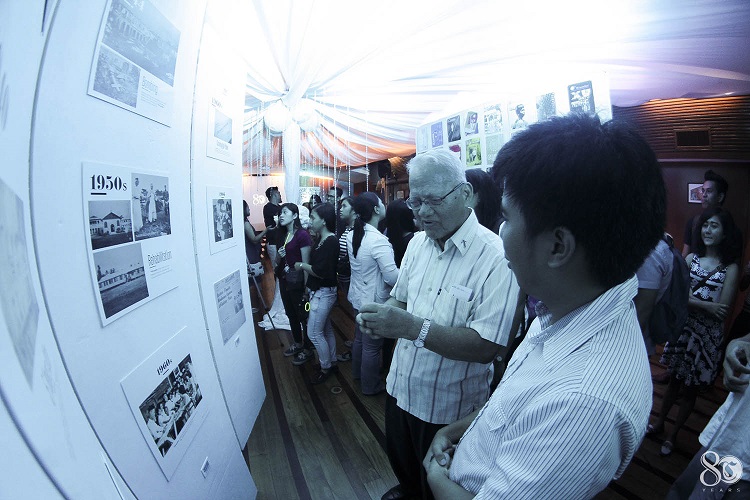RUBY YEAR. Past and present members of The Crusader Publication, along with other guests, grace the “Speak throughout the Ages” exhibit, featuring a timeline of important events, back issues and memorabilia that shaped the student paper over the course of eight decades. Lensed by Jigo Racaza/The Crusader Publication.
Story by Rezza Mae B Tolinero
The pursuit of telling the truth never gets old.
The Crusader Publication, the official student paper of Xavier University- Ateneo de Cagayan, celebrated its 80th anniversary this year by providing the community with a glimpse of its past. The current editorial board and staff staged a photo exhibit and documentary screening on December 3 to 5 at the AVR 1, Old Library, in time for the Xavier University Festival Days (XUFD) 2015.
The exhibit was graced by past members of the Publication and was open to all students and visitors. In line with XUFD’s theme, “Our Common Home,” incumbent editor-in-chief Xian Louis Patrick Arcayera shared that they had originally wanted to organize a homecoming event and a celebration dinner. “However, we felt that everyone in the community should be part of this celebration, because The Crusader, although autonomous, is still part of the XU community, and it has grown with Xavier.”
Aptly called “Speak throughout the Ages,” the exhibit featured the Publication’s history through a timeline of important events, past issues and memorabilia that shaped what The Crusader Publication is today. A wall of magazines ordered chronologically showcased the publication’s evolution in content, layout, and design throughout eight decades of service. The exhibit displayed a timeline of historical events and reproductions of some of the oldest The Crusader Publication issues with dates as far back as 1969. There was also a documentary showing past Crusader members sharing their experiences with the Publication.
Looking back
The Crusader Publication was founded in 1935. It was not a smooth start, however. Shortly after it became the official student publication of XU in 1940, the school had to close down because of World War II. When American planes bombed the city in 1944, leaving parts of the school in ashes, along went early copies of the Publication.
Production resumed in 1950 and The Crusader Publication slowly grew in influence and significance. In fact in 1960, it became a community newspaper throughout the region. In the early 1970s, it faced another setback with the declaration of Martial Law.
“We were cautioned not to write about the Marcos regime [and] student activism. We were told to write only the main things about the campus,” recalled Froilan Gallardo, a feature writer of The Crusader at the time. However, this threat of suppression only fueled student activism finding a channel in the Publication and becoming apparent in its writings.
Hindrance to the continuation of the Publication came not only from Martial Law. In 1978, a Jesuit priest ordered the closure of The Crusader without clear reasons. It was re-established almost a year after and continued to cover campus issues, such as the abolition and eventual re-instatement of the uniform policy, and tuition increase, as well as other topics of local and national significance, such as the impeachment cases of former presidents Joseph Estrada and Gloria Macapagal-Arroyo.
Exploring new platforms in the Information Age
Besides the regular production of printed magazines and newspapers, the Publication has opened a digital outlet with the launching of The Crusader Publication website in early 2000s. This undertaking signaled the start of other multimedia platforms for the Publication. News stories and online copies of published articles reached social media, and the Crusader began operating CruTV, its channel for telling stories in motion. CruTV features back-wrap news stories and other documentaries on topics relevant to the University and even the city such as the Sumilao Farmers, Tropical Sendong survivors and Misamis Oriental Provincial Jail (MOPJ) inmates.
Other than telling stories, the Publication has also ventured into organizing journalism students, teachers and practitioners in the city for an annual gathering called “Sibya.” Started in 2012, Sibya has featured notable and multi-awarded journalists as speakers, among them Maria Ressa, Patricia Evangelista, AG Saño, and Atom Araullo.
“I feel like Sibya is important. It has been able to address a big gap [between the students and the relevant issues], and The Crusader was really in the center of all those [exchange of ideas],” shared Ryan Louie Madrid who was the editor-in-chief then, and whose team initiated Sibya.
Another Crusader undertaking, “Project Banwag,” launched around the same time as Sibya, aims to help student and community publications by giving free seminar-workshops on journalism.
The Crusader Publication has established itself as a reliable source of news and information, and as a valuable member of the local community. Its most remarkable work in recent years has been its coverage of Typhoon Sendong.
“I think the one moment where The Crusader really cemented its place as a thought leader was when we covered Sendong in 2011,” shared Madrid. “We were there right at the very start until the end. I think that was very pivotal for The Crusader.”
Although several programs and projects have emerged, for The Crusader, the ultimate cause is still the same.
“One thing remains unchanged,” said Arcayera. “The Crusader will always pursue and speak about the truth. And it will continue to do so throughout the ages.”
